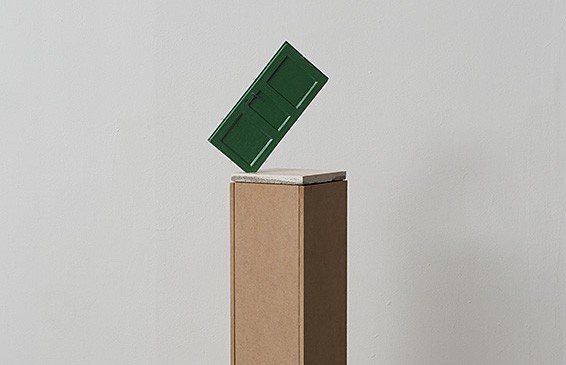
Nira Pereg. 5 Calls, Sun Clock, 2015, installation view. Floor tile and painted aluminium cast, 40 x 20 x 20cm; pedestal 120 x 20 x 20cm. Courtesy of Braverman Gallery and the artist.
“Aptitude for war is aptitude for movement,” said Napoleon, as quoted by Paul Virilio in his book, Speed and Politics.1 Virilio explains that “violence can be reduced to nothing but movement.”2 For him, mobility in our modern age is the direct result of political tension and repression under the democratic-capitalist world order:
The events of 1789 claimed to be a revolt against subjection, that is, against the constraint to immobility symbolized by the ancient feudal serfdom … a revolt against arbitrary confinement and the obligation to reside in one place. But no one yet suspected that the ‘conquest of the freedom to come and go’ … could, by a sleight of hand, become an obligation to mobility. The ‘mass uprising’ of 1793 was the institution of the first dictatorship of movement, subtley [sic] replacing the freedom of movement of the early days of the revolution. 3
The mass uprising of 1793, known as the levée en masse, was the policy of military conscription adopted in the aftermath of the French Revolution of 1789.4 This was the first time that national identity and the desire to protect a nation’s self-determination were the bases for joining the military. But while movement—both geographical and social—was once a freedom and a privilege, today it is an obligation.
Perhaps nowhere is this clearer than in the refugee crisis at Europe’s door. This issue is not new, but its scale and visibility is unprecedented since World War II. Related to this, Elizabeth Larison discusses a recent project by Atıf Akın and Dilek Winchester called Apricots from Damascus. Their publication and exhibition explore art in a state of mobility and exile, with a focus on Syrian artists, writers, musicians, and other creative professionals who have created a new community in İstanbul after fleeing the civil war in Syria.
Another look at movement as related to conflict is Talia Heiman’s review of Nira Pereg’s exquisite work, Ishmael, which traces the Kafkaesque scenario in Hebron’s Cave of the Patriarchs, a highly contested religious site physically divided between Jews and Muslims. Pereg’s video installation follows the muezzin’s labyrinthine route through the Jewish section of the cave as he is escorted by Israeli military to the site from which he calls followers to prayer five times a day.
Though under sadly restrictive circumstances, the muezzin’s slippage through the cave can be considered a metaphor for the artist and her maneuvering through complex systems to call our attention. Sky Goodden produces a poetic comparison between the movement of artists and migratory birds, aligning their flight patterns and their peripatetic patterning of survival. This text stems from a book Goodden is currently editing, titled The Floating Academy: Artist Residencies in Contemporary Art, an unprecedented examination of the risks and effects that a migratory population is having on the contemporary art world.
In another beautifully written experimental text, Joseph del Pesco exercises the imagination by considering a world in which exhibitions are short, temporary nations. His short story inspires thoughts on the role of art in a world bisected by nation-states.
Considering social movement, the Canadian choreographer Robert Binet pushes for change in ballet’s stifling gender roles. The artist collective Postcommodity introduces their large-scale installation Repellent Fence, which investigates perceptions of and misconceptions about immigration. Further examining social movement in the fine art realm, Sheldon Scott’s piece examines the Black Lives Matter movement’s place in contemporary art, and Olubukola Gbadegesin, a professor at Saint Louis University, probes art institutions’ belated acceptance of work by black artists.
Arthur Shimamura explores the origins of photography that captured movement, including the work of Eadweard Muybridge and Harold Eugene Edgerton. This issue will also consider work by the composer Julia Adolphe, the New England artist Gina Siepel, and the famous feminist collective, the Guerrilla Girls.
While the pieces in this issue can hardly encompass the myriad angles through which one might consider the theme of movement, they begin to explore many paths of thinking, from locomotion and performance to death and sovereignty. Ultimately, to paraphrase Virilio, the question of how our freedom of movement becomes an obligation to mobility must be asked by each of us.
— Chen Tamir
1. Paul Virilio, Speed and Politics: An Essay on Dromology (New York: Columbia University, 1986), 22.
2. Ibid., 38, paraphrasing Maurice de Saxe.
3. Ibid., 29–30.
4. “Levée en masse,” https://en.wikipedia.org/wiki/Levée_en_masse.